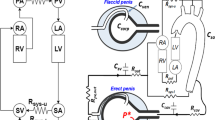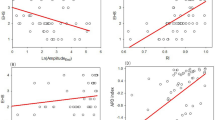Abstract
The authors aimed to study the skin surface bioheat perfusion model described in part I numerically. The influence of each constituent in the determination of surface temperature profile was statistically examined. The theoretically derived data will then be benchmarked with clinically measured data to develop the artificial intelligence system for the diagnosis of erectile dysfunction (ED). The new approach is based on the hypothesis that there exists a constitutive relationship between surface temperature profiles and the etiology of ED. By considering the penis model as a group of reservoirs with irregular cavities, we built a numerical model, simplified to save computational costs while still realistically able to represent the actual for partial differential calculation. Incompressible blood flow was assumed coupled with the classical bioheat transfer equation which was solved using the finite element method. Isotropic homogeneous heat diffusivity was assigned to each tissue layer. The results of simulations were tested for sensitivity analysis and further optimized to obtain the ‘best’ signal from the simulations using the Taguchi method. Four important parameters were identified and analysis of variance was performed using the 2n design (n=number of parameters, in this case, 4). The implications of these parameters were hypothesized based on physiological observations. Our results show that for an optimum signal-to-noise (S/N) ratio, the noise factors (thermal conductivity of skin, A and tunica albuginea, B) must be set high and low, respectively. Hence, at this setting, the signal will be captured based on the perfusion rate of the boundary layer of the sinusoidal space and the blood pressure (perfusion of sinusoidal space, C and blood pressure, D) will be optimal as their S/N ratios (C (low) and D (low)) are larger than the former.
This is a preview of subscription content, access via your institution
Access options
Subscribe to this journal
Receive 8 print issues and online access
$259.00 per year
only $32.38 per issue
Buy this article
- Purchase on Springer Link
- Instant access to full article PDF
Prices may be subject to local taxes which are calculated during checkout




Similar content being viewed by others
References
Aytac IA, McKinlay JB, Krane RJ . The likely worldwide increase in erectile dysfunction between 1995 and 2025 and some possible policy consequences. BJU Int 1999; 84: 50–56.
Impotence. NIH Consens Statement online 1992 Dec 7–9, 1992; 10: 1–31, www.nlm.nih.gov/medlineplus/.
Feldman HA, Goldstein I, Hatzichristou DG, Krane RJ, McKinlay JB . Impotence and its medical and psychosocial correlates—results of the Massachusetts Male Aging Study. J Urol 1994; 151: 54–61.
Gray A, Feldman HA, McKinlay JB, Longcope C . Age, disease, and changing sex-hormone levels in middle-aged men—results of the Massachusetts Male Aging Study. J Clin Endocrinol Metab 1991; 73: 1016–1025.
Lue TF, Takamura T, Umraiya M, Schmidt RA, Tanagho EA . Hemodynamics of canine corpora cavernosa during erection. Urology 1984; 24: 347–352.
Kandeel FR, Koussa VKT, Swerdloff RS . Male sexual function and its disorders: physiology, pathophysiology, clinical investigation, and treatment. Endocr Rev 2001; 22: 342–388.
Jiang LJ, Ng EYK, Yeo ACB . A perspective on medical infrared imaging. J Med Eng Technol 2005; 29: 257–267.
Ring EFJ . The historical development of thermometry and thermal imaging in medicine. J Med Eng Technol 2006; 30: 192–198.
Merla A, Ledda A, Di Donato L, Di Luzio S, Romani GL . Use of infrared functional imaging to detect impaired thermoregulatory control in men with asymptomatic varicocele. Fertil Steril 2002; 78: 199–200.
Merla A, Ledda A, Di Donato L, Romani GL . Assessment of the effects of varicocelectomy on the thermoregulatory control of the scrotum. Fertil Steril 2004; 81: 471–472.
Kukkonen TM, Binik YM, Amsel R, Carrier S . Thermography as a physiological measure of sexual arousal in both men and women. J Sex Med 2007; 4: 93–105.
He Y, Shirazaki M, Himeno R . A finite element model for determining the effect of peripheral blood flow on the finger temperature. Proceedings of the 6th ASME-JSME Thermal Engineering Joint Conference, Hawaii 2003; 6: TED: AJ03–AJ166.
Ng EYK, Ooi EH . FEM simulation of the eye structure with bioheat analysis. Comput Methods Programs Biomed 2006; 82: 268–276.
Kenny W, George H . Thermal physiology of the elderly and handicapped. J Therm Biol 1993; 18: 334–341.
Newman HF, Reiss H . Artificial perfusion in impotence. Urology 1984; 24: 469–471.
Newman HF, Marcus H . Erectile dysfunction in diabetes and hypertension. Urology 1985; 26: 135–137.
Sun P, Swindle R . Are men with erectile dysfunction more likely to have hypertension than men without erectile dysfunction? A naturalistic national cohort study. J Urol 2005; 174: 244–248.
Zemel P . Sexual dysfunction in the diabetic patient with hypertension. Am J Cardiol 1988; 61: H27–H33.
Kloner R . Erectile dysfunction and hypertension. Int J Impot Res 2007; 19: 296–302.
Kaufman JM, Borges FD, Fitch WP, Geller RA, Gruber MB, Hubbard JG et al. Evaluation of erectile dysfunction by dynamic infusion cavernosometry and cavernosography (DICC). Urology 1993; 41: 445–451.
Padma-Nathan H In: Lue TF (ed). Dynamic Infusion Cavernosometry and Cavernosography (DICC) and the Cavernosal Artery Systolic Occlusion Pressure Gradient: A Complete Evaluation of the Hemodynamic Events of a Penile Erection. Smith-Gordan: London, 1992, pp 101–103.
Taguchi G . Introduction to Quality Engineering. Asian Productivity Organization, UNIPUB, White Plains: White Plains, 1986.
Chung WS, Park YY, Kwon SW . The impact of aging on penile hemodynamics in normal responders to pharmacological injection: a Doppler sonographic study. J Urol 1997; 157: 2129–2131.
Acknowledgements
We thank Professor Dr Chia SJ, Head of General Surgery and Urology, Tan Tock Seng Hospital, Singapore, for sharing his views and interests on the work.
Author information
Authors and Affiliations
Corresponding author
Rights and permissions
About this article
Cite this article
Ng, E., Ng, W., Huang, J. et al. The engineering analysis of bioheat equation and penile hemodynamic relationships in the diagnosis of erectile dysfunction: part II—model optimization using the ANOVA and Taguchi method. Int J Impot Res 20, 285–294 (2008). https://doi.org/10.1038/sj.ijir.3901628
Received:
Revised:
Accepted:
Published:
Issue Date:
DOI: https://doi.org/10.1038/sj.ijir.3901628
Keywords
This article is cited by
-
Applications of artificial intelligence in the diagnosis and prediction of erectile dysfunction: a narrative review
International Journal of Impotence Research (2023)



